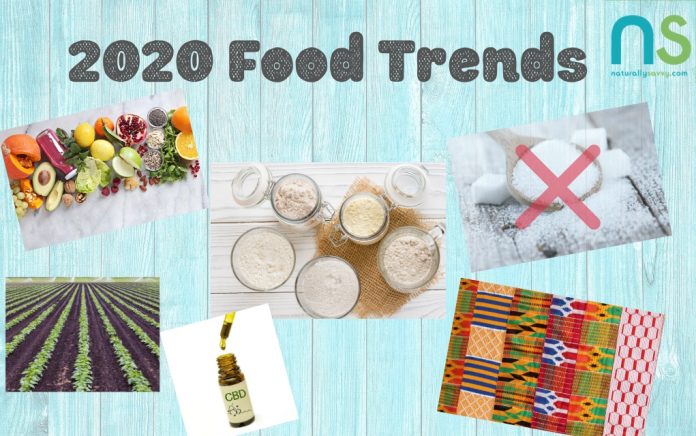
Yes, it’s that time of year again when we ring out the old and welcome the new. Of course, the lines are not clearly delineated when it comes to food trends, as there is usually some crossover from the previous year. So let’s look at the hottest food trends for 2020—which ones are you excited about? Did you see any of them coming?
Read about 11 hot food trends for 2019
Updated sugar substitutes
We have been gradually moving away from white table sugar and honey and embracing other sweet choices. In 2020, we may see a rise in the use of syrupy reductions from fruits and starches, such as coconut, dates, monk fruit, pomegranate, sorghum, and sweet potatoes. These sugar substitutes will grace not only desserts but marinates, glazes, and grain dishes.
West African influence
It’s time for a new cultural influence to tantalize our palates. West Africa consists of 16 nations, each offering some foods that may be completely foreign to many people in the Northern Hemisphere and elsewhere, yet others will be very familiar. West African foods include cassava, corn, dried peas, eggplant, fonio (an ancient grain), garlic, green vegetables, moringa, okra, peanuts, squash, tamarind, teff, and tomatoes. The three foods that are considered to be the basis of West African cooking are tomatoes, onions, and chili peppers.
Seed butters
With so many seeds from which to choose, it will be exciting to see which seed butters make it to the market place and hold on. You may come across anything from chickpea butter to macadamia butter or watermelon seed butter.
Use of food scraps and waste reduction
Is an answer to starvation around the world at our fingertips? The food wasted in Europe and the USA alone could feed all the people in the world three times over. Now food manufacturers, organizations, and governments are making it a priority to use food scraps and reduce food waste.
For example, misshaped vegetables and fruits will be appearing more in supermarkets and used in new products. Companies like Imperfect Produce and supermarkets like Tesco and their “Imperfectly Perfect” range of produce are helping chip away at the problem.
In Europe, there’s the “Too Good to Go” app that allows consumers to get food from restaurants for a minimal cost that would otherwise be thrown away. Scotland is aiming to reduce food waste by 33 percent by 2025, while Australia has set a goal to reduce their food waste by half by 2030.
Read more about 7 flour substitutes you may not know about
Regenerative farming
You may have heard this phrase during 2019, but 2020 could be the year it really takes off. As farmers and governments around the world focus more on climate change, land use, soil health, and growing food needs, the concept of regenerative farming has become more critical. It is the practice of increasing biodiversity, enhancing ecosystem services, capturing carbon, and “reversing current global trends of atmospheric accumulation.” It benefits consumers, farmers, and the planet—a win-win-win. Currently, there are some smaller food manufacturers using this concept. However, we should see more and larger concerns using regenerative practices very soon.
More flour substitutes
One reason flour substitutes rose to prominence is the growing concern about celiac disease and gluten intolerance. As the number of flour substitutes rises, it may prove to be difficult to not want to try them. Although you may already be familiar with coconut and almond flours, how about flour made from bananas, cashews, dragonfruit, mango, apple, carrots, sweet potato, or peanuts? Would you like to try a mixture of pumpkin, spelt, and figs?
In addition to the availability of specialty flour substitutes, you should see more baked goods that use them. Cakes, bagels, cookies, breads, and more will soon be available using a variety of novel alternative flours.
Meat/plant blended foods
The year 2020 should see the arrival of more blended meat products. Also known as blended burgers, the nonmeat portion may consist of mushrooms, pea protein, potatoes, squash, or carrots, among other plants. Such burgers are lower in fat, cholesterol, and sodium and higher in fiber and essential nutrients than traditional burgers. One effort is already underway: The Blended Burger Project, for example, mixes traditional burgers with at least 25 percent plant-based ingredients.
Upgraded kids’ food
It’s about time we upgraded the food children are eating in restaurants, in school, and at home. Thanks to millennial parents, some of today’s kids are being exposed to healthier food choices. According to Whole Foods Market staff, more children are joining their parents in reaching for more nutritious food choices. This can mean more organics, baked goods and pastas made with alternative flour, healthy on-the-go snacks, and nutritious alternatives to soft drinks.
Soy-free plant-based foods
When plant-based eating first broke into the marketplace, soy was king. Now consumers are looking for soy-free plant-based foods, especially since some people are allergic to or intolerant of soy. The year 2020 should see more soy-free foods made from avocado, hemp seeds, seitan (but stay away if you can’t handle gluten), chia seeds, jack fruit, seeds, mung beans, and other alternatives.
Healthy on-the-go snacks
Have our lifestyles gotten busier? If the demand for healthy on-the-go snacks is any indication, the answer is yes. At least one survey says that two-thirds of adults snack at least once a day. Recently it seems that people want healthier snacks, so the industry is meeting that call.
One area that is gaining attention is puffed, baked and popped snacks. Another is protein snacks, sometimes plant-based and typically savory and crunchy. Start checking out the supermarket aisles for these and other new additions.
CBD-infused foods
CBD-infused foods and beverages are available, especially online, and the demand is growing. The year 2020 may see a boon in this market segment. However, there is still the dark cloud of FDA approval hanging over the entire topic.
A number of food manufacturers (e.g., Ben and Jerry’s, Mondeleze, makers of Oreos and other foods) are waiting on the sideline with CBD-infused food ideas while the US government still holds the reins on approval. The waters are muddied: hemp-derived CBD products (which contain less than 0.3% THC) are illegal in some states but legal at the federal level. Marijuana-derived CBD items are legal in some states but not at the federal level.
Bottom line
Keep your eyes open and your stomach ready for the hottest food trends in 2020. Let us know what you think about these emerging entries into the supermarket and agriculture venues and share your experiences with us.
Sources
Burrell H. 2020 food trends: what changes will the food industry see in the new year? FoodBev Media 2019 Nov 16
Gingiss D. How Imperfect Produce turned ugly fruit and vegetables into marketing perfection. Forbes 2019 Apr 28.
Shirvell B. 10 food trends to look for in 2020, according to Whole Foods. Forbes 2019 Oct 21
The World Counts. World food waste statistics











